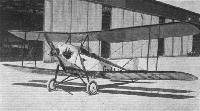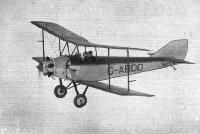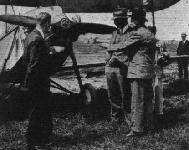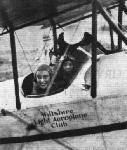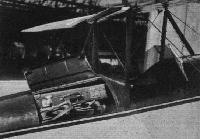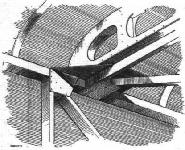
Robinson Redwing
Robinson Redwing - двухместный биплан с размещением членов экипажа бок о бок. Прототип построен "Robinson Aircraft Company Ltd" из Суррея, позже преобразованной в "Redwing Aircraft Ltd".
Первый полет Redwing I выполнил в 1930 году с 4-цилиндровым мотором A.B.C. Hornet мощностью 75 л.с.
Прототип Redwing II поднялся в воздух в октябре 1930 года с мотором воздушного охлаждения Armstrong Siddeley Genet IIA, за ним последовало девять серийных самолетов.
Финальным вариантом стал единственный построенный Redwing III с крылом меньшего размаха и закрытыми обтекателями колесами шасси. Позже его доработали до стандарта Redwing II.
Размах крыла самолета Redwing II - 9,30 м, мощность ПД Genet IIА - 80 л. с., максимальная скорость составляла 153 км/ч.
Описание:
- Robinson Redwing
- Flight, June 1930
INTRODUCING THE "REDWING" - Flight, December 1930
THE ROBINSON "REDWING MARK II - Flight, November 1932
British Aircraft
Фотографии
-
Air Enthusiast 2003-01 / J.Cotter - A rare bird
Регистрационный номер: G-ABNX [23] G-ABNX regularly flies from Redhill.
-
Мировая Авиация 223
Регистрационный номер: G-ABNX [23] Redwing II был неплохим самолетом, но не смог выиграть конкуренцию у доминировавших на рынке de Havilland Moth и Avro Avian.
-
Air Enthusiast 2003-01 / J.Cotter - A rare bird
Регистрационный номер: G-ABNX [23] G-ABNX taxies out at Redhill. In the right seat is John Pothecary who rebuilt the aircraft.
-
Air Enthusiast 2003-01 / J.Cotter - A rare bird
Регистрационный номер: G-ABNX [23] Pilot Nocholas Parkhouse in G-ABNX following a flight at Redhill.
-
Air Enthusiast 2003-01 / J.Cotter - A rare bird
Регистрационный номер: G-ABNX [23] G-ABNX is ideally situated at Redhill, the aircraft being very much a part of Surrey's aviation heritage.
-
Air Enthusiast 2003-01 / J.Cotter - A rare bird
Регистрационный номер: G-ABNX [23] John Pothecary turns the propeller prior to start-up.
-
Air Enthusiast 2003-01 / J.Cotter - A rare bird
Регистрационный номер: G-ABNX [23] Redwing II G-ABNX, the sole survivor of its type, sits out on the grass at Redhill on August 16, 2002, the day the Redwing Preservation Trust was launched.
-
Air Enthusiast 2003-01 / J.Cotter - A rare bird
Регистрационный номер: G-ABNX [23] Close-up showing the five-cylinder Genet.
-
Air Enthusiast 2003-01 / J.Cotter - A rare bird
Регистрационный номер: G-ABNX [23] The Redwing features an exceptionally wide track undercarriage.
-
Air Enthusiast 2003-01 / J.Cotter - A rare bird
Регистрационный номер: G-ABNX [23] Detail shot of the Redwing' sturdy undercarriage.
-
Air Enthusiast 2003-01 / J.Cotter - A rare bird
Регистрационный номер: G-ABNX [23] Pippa Martin, daughter of John Lane, is a keen supporter of the Redwing.
-
Air Enthusiast 2003-01 / J.Cotter - A rare bird
Регистрационный номер: G-ABNX [23] Members of the Redwing Preservation Trust assembled by G-ABNX at Redhill in August 2002.
-
Aeroplane Monthly 1982-06
Регистрационный номер: G-ABNX [23] John and Jenny Pothecary swanning along in their 1932 Robinson Redwing a year or two ago. Celebrating its 50th year, the Redwing is still active today.
-
Air Enthusiast 2003-01 / J.Cotter - A rare bird
Регистрационный номер: G-AAUO [6] Redwing I G-AAUO fitted with the ABC Hornet engine, which was later replaced with the Genet.
-
Aeroplane Monthly 1983-09 / J.King - From Little Acorns
Регистрационный номер: G-AAUO [6] Redwing G-AAUO with some local beauty at Gatwick during the hot summer of 1932.
-
Aeroplane Monthly 1980-04 / Plane Crazy
Регистрационный номер: G-AAUO [6] "But yon 'an gar's for me 'plane, not your bleedin' 'ay!"
-
Flight 1930-06 / Flight
Регистрационный номер: G-AAUO [6] THE ROBINSON "REDWING": Designed by Mr. John Kenworthy and built by the Robinson Aircraft Co., Ltd., this machine is a side-by-side two-seater of wood construction. The engine is an A.B.C "Hornet" of 75 h.p.
-
Flight 1930-07 / Flight
Регистрационный номер: G-AAUO [6] A TWO-SEATER, side-by-side biplane of recent production and of wood construction. Designed for very low landing speed and ease of handling by pilots of only medium skill. The engine is an A.B.C. "Hornet."
-
Flight 1930-06 / Flight
Регистрационный номер: G-AAUO [6] The "Redwing": This view of the nose gives a good idea of the neat engine cowling, the undercarriage, &c.
-
Flight 1930-06 / Flight
GETTING AWAY: With its light wing loading the "Redwing" has a very good take-off and climb.
-
Flight 1931-03 / Flight
Регистрационный номер: G-ABDO [6] A WINTER CRUISER: The Robinson "Redwing II," which is fitted with Armstrong Siddeley "Genet" engine, recently made a tour of about 1,000 miles to various towns in England. The machine is here seen at an altitude of 5,000 ft. above the clouds.
G-ABDO was the prototype of this mark of this side-by-side two-seat biplane, designed by John Kenworthy and built by the Robinson Aircraft Co Ltd, founded at Croydon, surrey, by Capt P.G. Robinson. First flown in October 1930, ’BDO was powered by an 80 h.p. Armstrong siddeley Genet IIA air-cooled radial engine. It was used by the newly formed London General Omnibus Company Flying Club, based at Broxbourne, hertfordshire, and the manufacturer’s test pilot, Flt Lt N.M.s. Russell, became the club’s first instructor. Granted its C of A on December 6, 1930, it passed to Miss E.R. Gerrans at Maylands, Romford, essex, in August 1934, but in July 1937 was damaged in a hangar fire at Gravesend in Kent. -
Flight 1931-03 / Flight
Регистрационный номер: G-ABDO [6] The Redwing being flown by Flight-Lieut. Russell, who is the Robinson Aircraft Co.'s chief pilot. The clean lines of the fuselage should be noted.
-
Flight 1930-12 / Flight
Регистрационный номер: G-ABDO [6] SIDE BY SIDE SEATING: The latest "Redwing" produced by the Robinson Aircraft Co. is similar in general construction to the first machine, but the engine is an Armstrong-Siddeley "Genet" for which a very neat cowling has been designed. An undercarriage of long stroke is provided so that landings are particularly smooth.
-
Flight 1930-11 / Flight
Регистрационный номер: G-ABDO [6] THE ROBINSON "REDWING MARK II": This side view shows that the lines of the fuselage are good, in spite of the side-by-side seating. Note the unusual shape of the rudder, which gives the machine a distinctive appearance.
-
Flight 1930-12 / Flight
Регистрационный номер: G-ABDO [6] THE ROBINSON "REDWING MARK II": Three-quarter rear view.
-
Flight 1930-12 / Flight
Регистрационный номер: G-ABDO [6] THE ROBINSON "REDWING MARK II": The telescopic legs of the undercarriage run to the top longerons.
-
Flight 1931-11 / Flight
Регистрационный номер: G-ABNP COLCHESTER: The Blue Barns Aerodrome at Colchester is now the sales depot of the Redwing Aircraft Co., Ltd., for all territory north of London. Here is shown a group of Redwings when the depot was opened by Flt.-Lt. Russell.
-
Aeroplane Monthly 1983-09 / J.King - From Little Acorns
Регистрационный номер: G-ABNX [23], G-ABOK Robinson Redwings G-ABNX and G-ABOK at Gatwick in April 1933. ’NX is still airworthy and is currently owned by John Pothecary.
-
Aeroplane Monthly 1980-09 / Personal album
Регистрационный номер: G-ABNX [23] Robinson Redwing G-ABNX, a familiar participant at today’s airshows, was first owned by C. P. Hunter of Hooton Park, Cheshire, and had many successive owners until 1953, when it went into hibernation. In 1959 it was purchased by John Pothecary and Ted Gould and restored to airworthy condition in March 1962. Today the Redwing is still owned by John Pothecary, and is scheduled to be the subject of an early Preservation Profile feature.
-
Aeroplane Monthly 1983-09 / J.King - From Little Acorns
Регистрационный номер: G-ABNX [23] Robinson Redwing G-ABNX and a British Airways Concorde were both visitors to Gatwick on August 25, 1980 to celebrate the airport's golden jubilee.
Другие самолёты на фотографии: SNIAC, BAC Concorde - International - 1969
-
Aeroplane Monthly 1980-11 / Robinson Redwing G-ABNX /Preservation Profile/
Регистрационный номер: G-ABNX [23] G-ABNX at the 50 Years of Flying Exhibition, Hendon, July 1951.
-
Aeroplane Monthly 1980-11 / Robinson Redwing G-ABNX /Preservation Profile/
Регистрационный номер: G-ABNX [23] G-ABNX painted up for a forthcoming TV series.
-
Aeroplane Monthly 1980-11 / Robinson Redwing G-ABNX /Preservation Profile/
Регистрационный номер: G-ABNX [23] -
Aeroplane Monthly 1976-12
Регистрационный номер: G-ABNX [23] John Pothecary’s unique Robinson Redwing II during an appearance at Old Warden earlier this year.
-
Air-Britain Archive 1980-04
Регистрационный номер: G-ABNX [23] Robinson Redwing 2 G-ABNX making a leisurely approach to Sywell's runway during the 1976 PFA Fly-in.
-
Flight 1930-06 / Flight
The Christening Ceremony: Air Vice-Marshal Sir Sefton Brancker, Director of Civil Aviation, "unveils" the name "Redwing."
-
Flight 1930-06 / Flight
The Power Plant: Mr. Dennis (right) pointing out to Lord Ridley (Chairman of A.B.C. Motors) the neat cowling of the A.B.G. "Hornet" on the "Redwing". On the left is Mr. Elliott, who designed the "Hornet."
-
Flight 1931-10 / Flight
Lady Page and daughter, Miss Joan Page, arrive at the Garden Party after flying from Hanworth in a "Genet-Redwing." Miss Page is an enthusiastic member of the Wiltshire Light Aeroplane
Club. -
Flight 1930-12 / Flight
THE ROBINSON "REDWING MARK II": On the left a view of the undercarriage and the neat cowling of the "Genet" engine. On the right a photograph, taken while the machine was in course of construction, showing the undercarriage, with compression rubbers. Portion of the engine mounting is also visible.
-
Aeroplane Monthly 1983-09 / J.King - From Little Acorns
The photograph is an aerial view of Gatwick taken in May 1933 with two Redwings parked outside the minute hangar. Redwing Aircraft Ltd took over the ownership of the aerodrome the previous year. The Surrey Aero Club clubhouse can be seen to the right of centre of the picture.
-
Flight 1931-09 / Flight
A FINE ATTENDANCE: Sywell from the air, showing the large number of aircraft which attended the All Women's Meeting. In the left foreground is a Comper Swift (Pobjoy) and two Redwings (Genet). Formations of three of each of these aircraft were a feature of the meeting.
Другие самолёты на фотографии: Comper Swift / CLA.7 - Великобритания - 1930
-
Air Enthusiast 2003-01 / J.Cotter - A rare bird
Регистрационный номер: G-ABNX [23] The Redwing's instrument panel.
-
Air Enthusiast 2003-01 / J.Cotter - A rare bird
Регистрационный номер: G-ABNX [23] Side-by-side seating arrangement in G-ABNX.
-
Flight 1930-06 / Flight
A large luggage locker, with rearward extents on for golf clubs, is a feature of the "Redwing."
-
Air Enthusiast 2003-01 / J.Cotter - A rare bird
Original 1930s Redwing advertisement.
-
Air Enthusiast 2003-01 / J.Cotter - A rare bird
Two advertisements promoting the Redwing's pilot-friendly flight characteristics.
-
Flight 1930-12 / Flight
Details of the fuselage construction. The covering is plywood, except the bottom, which is fabric.
-
Flight 1930-12 / Flight
The bent axles of the undercarriage are hinged to the cross-tubes in the bottom of the fuselage. The brackets on each side of the hinge carry the engine control rods.
-
Flight 1930-12 / Flight
The wing-folding device. T-cranks are mounted on the roots of the lower planes, with cables to the ailerons and links to the pilot's controls.
-
Flight 1930-12 / Flight
Pedals are used instead of foot bars for the rudder control. The pedals can be adjusted for length.
-
Flight 1930-12 / Flight
On the left a sketch showing rib construction, and on the right the neat end of an interplane strut.
- Фотографии

















